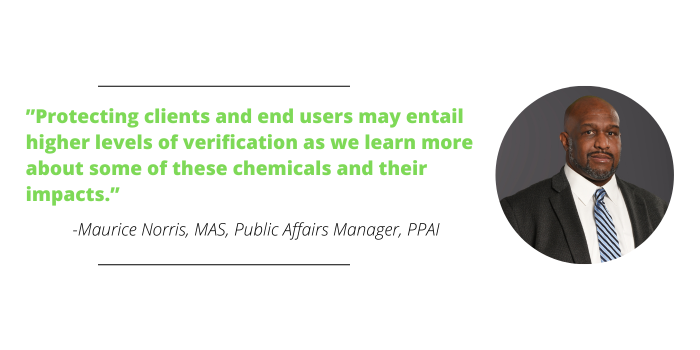5 Legal Concerns Food Suppliers Should Be Wary Of In 2024

As product safety is increasingly scrutinized, promotional products firms must be committed to performing due diligence to protect themselves.
Food and beverage suppliers, in particular, should stay on top of recent and upcoming rulings that will impact their business.
Below are five legal concerns that these companies should prepare for in 2024.
- FTC's Revised Green Guides Will Influence ESG Litigation
To help marketers avoid making environmental marketing claims that are unfair or deceptive, the Federal Trade Commission introduced its Green Guides in 1992.
Sometimes what companies think their green claims mean and what consumers really understand are two different things, and the FTC’s Green Guides are designed to help marketers avoid making environmental claims that mislead consumers. Environmental, social and corporate governance (ESG) litigation claims in the food and beverage space often fall within the scope of the Green Guides.
Guidance includes:
- General principles that apply to all environmental marketing claims.
- How consumers are likely to interpret particular claims and how marketers can substantiate these claims.
- How marketers can qualify their claims to avoid deceiving consumers.
In December 2022, the FTC announced that it was going to update the Green Guides, seeking comments from the public on terms such as “recyclable,” “recyclable content,” “organic,” “sustainable” and “degradable.”
Expected to be issued in 2024, the revised Green Guides will most likely impact food suppliers who rely upon such marketing claims, especially the “organic” label, to differentiate their products from the competition.

“We’ve been anticipating the FTC upgrading its Green Guides for some time now,” says Maurice Norris, MAS, public affairs manager at PPAI. “Hopefully, the FTC provides clarity on the meanings of several words that weren’t in wide circulation when the Guides were initially released. That said, due diligence is critical, and this applies to these topics and beyond. Protecting clients and end users may entail higher levels of verification as we learn more about some of these chemicals and their impacts.”
- Increased PFAS Litigation
Perfluoroalkyl and polyfluoroalkyl substances (PFAS) are persistent, bio-accumulative, man-made chemicals – commonly referred to as “forever chemicals” – that have been used in manufacturing and consumer products since the 1940s.
- PFAS are used to make textiles, electronics, wires and cables, pipes, cooking and bakeware, sports equipment, automotive products, toys, transportation equipment and musical instruments, according to the Environmental Protection Agency (EPA).
- Scientific studies have shown that exposure to some PFAS in the environment may be linked to harmful health effects.
In November, the EPA issued a final rule under the Toxic Substances Control Act (TSCA), which mandates reporting related to past manufacturing of PFAS substances. The ruling is expected to provide the public with the largest database of PFAS made and used in the United States.
- As a result of the final rule of TSCA, PFAS manufacturers and importers – including those in the promotional products industry – are estimated to spend approximately 11.6 million hours complying with this new rule, with an associated cost of $800-$843 million.
While governments at the state and federal level, and around the world, enact regulations controlling or prohibiting the use of PFAS, there’s no uniformity to the legislation. These rules apply to different product categories, follow different schedules, require different testing and mandate different responses.
Plaintiffs’ attorneys are likely to capitalize on the confusion, according to Abby Meyer and Khirin Bunker, partner and associate at international law firm Sheppard Mullin.
“Plaintiffs' interest in these cases continues to be predicated on consumer fear of PFAS chemicals, which may in part be fueled by articles published by consumer reports and other groups that have conducted product testing,” they said in an article for Law 360. “The findings of these articles have featured prominently in the complaints filed by consumers.”
It’s important to remember, Norris adds, that lawsuits relating to chemical compliance don’t necessarily involve government entities. “Some of the lawsuits involving PFAS were brought by the same groups that are actively enforcing Prop 65,” he says. “This doesn’t change what we already know: testing and documentation, among other things, are key to mitigating risk exposure.”
- Citric Acid and Malic Acid Will Remain Targets
Including citric acid and malic acid in products will still be targets for lawsuits, according to Meyer and Bunker.
- Citric acid, which is found naturally in lemons, limes and other citrus fruits, can also come in a manufactured version that’s often used as an additive in food products.
- Malic acid, which is found naturally in apples, cherries and other fruits, can be used as an additive providing a sour taste.
While food manufacturers may add these ingredients for the sole purpose of enhancing flavor, Meyer and Bunker argue that consumers may allege that their inclusion renders a “no preservatives” label as misleading.
“This is another example of how important due diligence is with making marketing claims,” Norris says. “There could be multiple uses for chemicals present in products and it’s wise to be aware of what these trends are to protect your business.”
- Beware Statutory Damages Under New York Law
In New York, consumers can file a claim for a deceptive act under Section 349 of the New York General Business Law. They also may have a claim under Section 350, which prohibits false advertising.
- Section 349 provides for $50 in statutory damages per violation.
- Section 350 provides for $500 in statutory damages per violation.
However, in the context of class action lawsuits, some district courts address violations on a per-person basis and others on a per-purchase basis, according to Meyer and Bunker. “Without settled precedent, plaintiffs’ counsel will likely continue to use the threat of exorbitant GBL statutory damages as leverage in false advertising class actions,” they said.
That precedent may come sooner rather than later, as there’s a case currently pending (Montera v. Premier Nutrition Corp.) in the U.S. Court of Appeals for the Ninth Circuit that may determine the calculation of violations in advertising cases.
“Larger states like New York often serve as incubators for legislative and regulatory developments,” Norris says. “We often see proposals from certain states copied in others and in Congress. That same idea applies here. Cases that originate at the state level can end up in federal court with broader implications.”
- McGinity Decision May Benefit Suppliers
In June 2023, the Ninth Circuit ruled in its McGinity v. Procter & Gamble Co. decision that when “a front label is ambiguous, the ambiguity can be resolved by reference to the back label.”
The case involved a consumer alleging that a shampoo product with the phrase “Nature Fusion” on the front of the bottle misled him to believe that the product was more natural than it actually was.
- The U.S. District Court for the Northern District of California ruled that the phrase doesn’t mean that there aren’t any synthetic ingredients, which could be confirmed by reading the list of ingredients on the back of the bottle.
The Ninth Circuit agreed, ultimately ruling that the onus is on the consumer to perform their own due diligence when checking the ingredients of a product. Perhaps this will reduce the amount of false advertising claims that companies in any industry face in 2024 and beyond.

